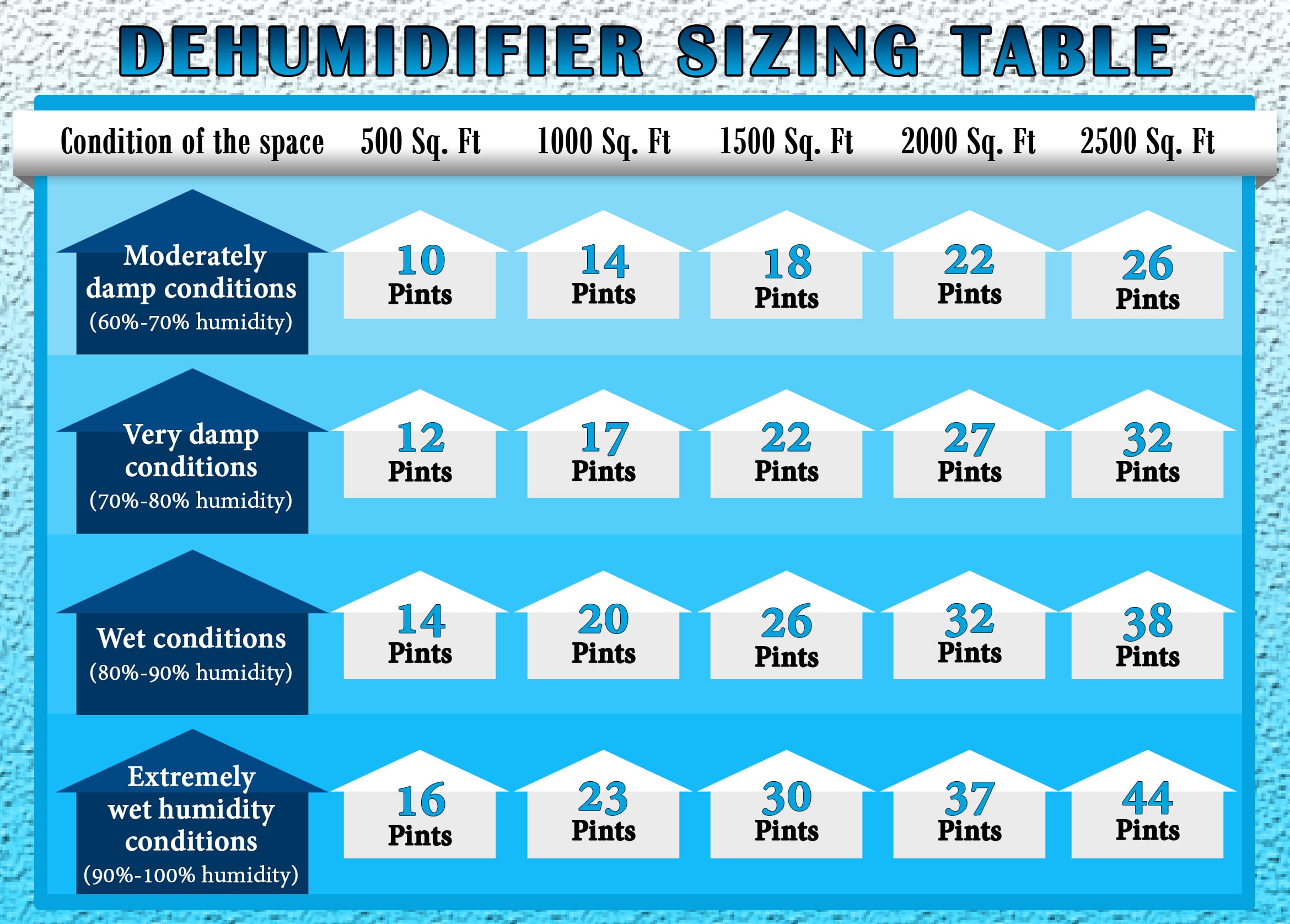If you couldn’t tell by now, its Summer and this is the time of year that many homeowners are complaining of high humidity in their home. And with good reason. Anyone who has experienced the phenomenon of walking outside and immediately looking and feeling as though they just got out of a pool with all their clothes on knows what I’m talking about. Humid air is UNCOMFORTABLE! It makes the air feel warmer since it retains moisture, making your skin feel stickier and causing you to sweat more. Excess humidity and the moisture it carries with it also wreak havok on your home as the affected area(s) smell as the moisture attaches and builds up on surfaces to create mildew and mold. The closer you get to 70% indoor humidity, the more risk you run of having mildew and mold buildup. Mildew and mold will destroy drywall and other surfaces which creates a need for repair… and that my friend requires additional money and time. End of story, high humidity is not good for your home which is another reason outside of discomfort that it’s not good for you. Be proactive instead of reactive.
Bear with me; this might be a bit of a stretch. It just dawned on me that humidity is very much like weeds and quality air is like grass, then you have the lawn mower being the A/C. Nobody likes weeds, nobody likes high humidity. After you mow your lawn the weeds blend in pretty well with the grass just as it is difficult to visually distinguish air as humid or not after it goes through the A/C. That is until the weeds get out of control since they grow a little faster, look a little different in color and eventually stand out just as high humidity will begin to cause water beading on glass, stains on your drywall or surfaces, and turn to mold or mildew. Plus, weeds aren’t nearly as comfortable to walk on with your bare feet just as humid air isn’t nearly as comfortable to be lounging in around your home. A little out there but you get the point.

Now where were we? That’s right, summertime humidity is a real pain in the a**, but fortunately there are solutions out there available to you. For this, we discuss a dehumidifier. The name speaks for itself and it is a great way to remove all that unwanted humidity but there are many options to pick and choose from. Consider these factors when selecting a dehumidifier:
- How damp is the area you wish to dehumidify? There are 4 main buckets of humidity level when selecting the right size. These are dependent on what is going on in your home:
- Moderately Damp – room(s) only smell musty when the weather outside is humid and not year round. Indoor humidity reading of 60-70%.
- Very Damp – The musty smell is now clear but you probably don’t see mold/mildew or water stains. Indoor humidity reading of 70-80%.
- Wet – The musty smell is clearly mold/mildew, visible signs of mold/mildew, water staining on ceilings and walls may be visible. Indoor humidity of 80-90%.
- Extremely Wet – Smell is overwhelming, visible signs of mold/mildew, water staining and damage, standing water inside your home. Indoor humidity of 90-100%.
- How big of an area are you looking to dehumidify? Take the total square footage of the room or area you wish to use the dehumidifier in. Many people only have a need for one in certain rooms (rooms furthest from the AC, basement, rooms on upper level, etc.) rather than the entire home, plus portable units can be moved around the home fairly easily if you had a desire to dehumidify more rooms. For this reason, finding the square footage of your largest room will allow you to have a dehumidifier for all your rooms.
- How energy efficient are you wanting to go? As with anything these days, more efficiency is linked to a higher upfront cost. If you are making a long term investment and plan to use a dehumidifier for years to come, then more efficiency will likely pay off. If you are only getting the dehumidifier for a single season while you fix bigger problems in your home like the HVAC system, insulation and air tightness then the added cost of efficiency may not be in your interest as its unlikely you will recover the price difference in savings.

Selecting the right size dehumidifier is one of those rare occasions in HVAC where it’s probably in your best interest to error on the bigger side (compared to the absolutely right size) and simply dial back the settings because a unit that is too small will need to be turned all the way up and still won’t get you the results, which is costing you more in energy use while not fixing the problem. A larger unit is essentially a fail-safe, especially with all the technology these days allowing you to precisely choose the correct settings so you aren’t wasting energy while still knowing you have more than enough power to get the job done.
Since dehumidifier sizes are listed in pints, meaning how many pints of water per hour the equipment removes, it might be easier to just reference the graphic above. These are ballpark numbers and could be influenced by other factors in your home such as how close it will be to the laundry room, dishwasher, showers, number of people in the home, climate zone, etc. The graphic also only shows up to 2500 square feet and there are larger homes out there. Look for the pint capacity to be tested at AHAM conditions which standardizes the test at 60% average humidity. Other manufacture listed specs can vary and may even be tested at 100% humidity so the real world results may vary. This is where a professional can test your home and make precise recommendations since each home will have different needs and there isn’t really a “one size fits all” to this.
There are 2 Main Types of dehumidifiers: Portable Dehumidifiers and Stationary Whole House Dehumidifiers. Both have their pros and cons, and the one for you just depends on your unique situation and how far you are willing to go. Let’s break it down.
Portable Dehumidifiers Pros:
- Small in size / Compact
- Generally less expensive to purchase
- A DIY project. It doesn’t require much in terms of installation, you might need to run an overflow hose to a sink.
- Portable so you can move it from room to room or get rid of it all together without ever knowing it was there
- Greater amount of options
Portable Dehumidifiers Cons:
- Most portable units can only hold so much water before you need to empty it (unless you have a hose for the overflow). Don’t worry, it won’t overflow but instead will alert you that its full and hold off on any further cycling until it has been emptied.
- Part #2 of a full water reservoir is that the system wont run if it reads full. So if you have very humid conditions, you might leave for work, fill up the reservoir and come back to humid air. Then you’ll be scratching your head trying to figure out why you even bought it.
- Takes up floor space (not much but none the less it takes up an area that could be open or where other furniture could go)
- Multiple units are generally required when you attempt to dehumidify an entire home

Stationary Whole House Dehumidifiers (As seen on the left) Pros:
- It is out of site (up in your attic or maybe in a crawl space depending on the layout of your home)
- Automatically drains water to the outside and doesn’t require you to constantly empty it
- Packaged with a humidistat that runs in tandem with your thermostat and lets you control the humidity from a central location.
- Wireless capability. There are wireless options to make it even more convenient when controlling indoor humidity. I couldn’t find a wireless portable unit though I’m sure it’s in the works.
- Control the humidity of the entire home, not just an area.
Stationary Whole House Dehumidifiers Cons:
- More costly to buy
- Requires some skill when installing, not the simplest DIY project. A professional installation adds more cost
- Involves cutting into drywall for new return or the duct work, running electrical and installing a humidistat
- Maintenance is more complicated compared to a simple portable dehumidifier
Overall it comes down to your unique situation. If you are in a mild climate zone that experiences minimal humidity concern then maybe you are better off just using a portable unit for a month or two. If you live in a climate zone that is constantly humid then the cost of a whole house unit will pay for itself in comfort and convenience alone. Your local HVAC professional will have many testing instruments to precisely diagnose what is going on in the home and provide you solutions. Heck, maybe you don’t need a dehumidifier at all and you AC just needs tuned or the refrigerant is low. Maybe your ducts are just leaky and conditioned air isn’t capable of circulating properly. The solution might not be adding a dehumidifier at all but getting the HVAC equipment already in your home inspected to remedy the problem. When’s the last time you had your HVAC system and duct work checked because you may be long overdue. Isn’t it about time you started enjoying the comfortable air you deserve?
